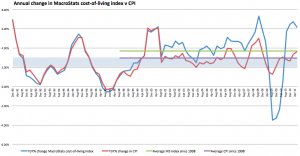Quality adjustments to the rent price index are another strange feature of the treatment of housing in CPI. The scope of quality adjustments to rental price index has lead to this absurd result:
…that for the period December 1994 to December 2005 the average rent paid by private tenants included in the ABS Survey of Income and Housing increased by 41.1%, while the increase in the CPI rental component was 22.9%
As I said last week, it is about time that the silent quality adjustments creeping into the CPI be made public so we can better evaluate just what this means out there in real life.
Advertisement
For some reason the RBA doesn’t seem too bothered by changes in the CPI methodology, particularly relating to the price of housing.
Currently, housing-related costs – including rents, utilities and the cost of building new dwellings – account for around 20 per cent of the CPI, the largest share of any single group. Broadly speaking, the housing component of the CPI shows the same general pattern as that in underlying inflation, although the recent moderation is less pronounced.
The bank also has a particularly strange argument to explain why high house price inflation is not a concern. They state that the large run-up in Australian house prices that was driven by the adjustment to low inflation ended in late 2003. Yet inflation in the 1990s was around 2.1% on average, and increased quite dramatically from 1998 to 2003 during the run-up in house prices. Of course, the RBA doesn’t use headline inflation measures anyway. They have their own favourite price measure – the average of the weighted median and trimmed mean CPI.
So where does that leave us? We can combine the main areas where housing has been stricken from the CPI – the removal of mortgage costs, quality adjustments to rent, and reduction in weight to home ownership costs – to see what difference it would make had the pre-1998 methodology been continued. The resulting MacroStats cost-of-living index is plotted below against the headline CPI.
This measure uses a continuous weighting adjustment between weight revision years (1998, 2000, and 2005), and applies a weight to owner-occupied housing costs consistent with the weighting in the ABS 2006 publication on housing in the CPI as well as applying the amended mortgage cost index in lieu of the new house purchase index. It also makes a slight adjustment to the rent price index since 1990 (20% increase in growth rate compared to the almost 100% increase observed using mean measures) to remove a little of the quality adjustment.

Advertisement
We can again see how this measure tracks the official CPI very closely until 1998. Since 1998 it is 0.73 percentage points higher on average (or 3.8%), and in the period 2001-2008, it averaged 1.3 percentage points higher (or 4.4%pa). That gives you some idea of how significant the 1998 methodological shift in the CPI was in disguising housing inflation and creating a feedback loop with lower monetary policy.
So what does this all mean? For me there are four key lessons.
1. The treatment of housing needs to be consistent in a pure price index with its treatment of a flow of services. You can’t include a capital cost in the form of new house purchases without including land, but also include a cost-of-service price for rental homes. My recommendation is to treat owner-occupied housing in the form of imputed rents with a weight in the basket approximating the weight to mortgage payments.
2. If home ownership is a policy goal, cost of living indexes should treat home buying and renting households separately. This will ensure that any policy aimed at making home owning more attractive can be evaluated by comparing these metrics.
3. In all both pure price and cost-of-living indexes quality adjustments, particularly regarding heavily weighted items such as rent, need thorough explanation and should be published alongside standardised measures such as mean and median prices.
4. Be extremely careful comparing economic performance between time periods using the CPI to deflate nominal price to real prices.
Discuss in our Forums
See what other readers are saying about this article!
Click here to read & post comments.
7 posts so far.